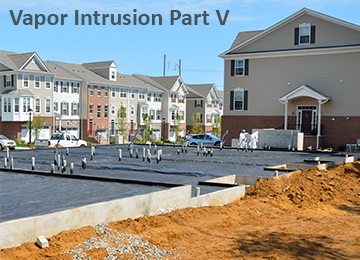Over the last couple of blogs we discussed what a VOC is, where VOCs can come from, how VOCs enter buildings, and why VOCs are a concern. In this final session, we will talk briefly about how we keep VOCs from entering a building or how to remove them if they are already entering an existing building. Since VOCs enter buildings because of a gradient or pressure differential; i.e. there are more VOCs below the slab than above, the way we stop VOCs from entering a building is to install a barrier below the slab (or above) and/or lower the pressure below the slab or increase the pressure inside the building. We refer to these barriers as a vapor mitigation system. So how do we do that?
The process is much simpler if the building has not been constructed yet, so all the more reason to conduct your soil gas survey before you build than after. In new construction, there are three modifications to the vapor mitigation system. The first is simply installing a vapor barrier above the gravel sub-base of the foundation. This barrier can be a thick (30 to 60 mil) plastic layer or a liquid sprayed on material. In either case, the barrier has to be properly sealed along all the penetrations (utility pipes extending through the slab) and footings. This barrier is installed before the concrete slab is poured. The mitigation system can be upgraded by installing a sub-slab depressurization system (SSDS) under the barrier. These can either be passive or active. These systems consist of slotted pipe installed in or on top of the gravel and are then connected together. The barrier is then installed on top of the pipe system. The pipe system is then vented above the roof line. The passive system relies on natural pressure differentials or a wind turbine on the roof vent to lower the pressure. In an active system, an electric blower is installed in the pipe system which draws air through the system, lowering the pressure. Obviously the active system is the Cadillac and is the most expensive, but also offers the greatest measure of safety. This system truly lowers the pressure below the slab and draws the VOCs out before they move into the building. Bye bye VIC.
If a building already exists and vapor intrusion becomes an issue, the problem can be fixed, but as you would expect, the fix is a bit more difficult. We can install a SSDS by either cutting trenches through the slab, installing the piping system as described above, or by installing depressurization points at selected locations throughout the building. In this case a pipe is installed through the slab and vented through the roof. An electric blower is installed to lower the pressure below the slab. The difficulty with installing a SSDS after the fact is we generally do not know how the building foundation was constructed; how thick is the gravel sub-base and whether one exists at all, are there footings located under the slab, etc.. Each of these situations can reduce air movement under the slab reducing the effectiveness of the SSDS.
An alternative to reducing the pressure below the slab is to increase the pressure inside the building (think of the old football stadiums with the “inflatable roof”). If the pressure inside the building is greater than the pressure below the slab, then VIC and his buddies cannot move up into the building. We do this by “pumping air” into a sealed building faster than it can leave. This requires a fairly well sealed building and an oversize HVAC system. Obviously this type of system will only work in certain types of buildings. A warehouse with large bay doors open all the time would probably not be a good candidate.
The final design of the vapor mitigation will depend on many factors; is the building going to be used for residential or commercial use, how shallow is the groundwater, what type of VOCs are present and their concentrations, how will the building be constructed or is constructed. Once these factors are known, the design professional can design a system, generally in concert with the regulatory agency.
So ends our journey, tracing the path of pesky VOCs from their source, through the soil, and into your building. Fortunately the problem can be remediated.
I hope this information was helpful and the presentation less painful than reading a technical journal.
Read the Series:
Who Is Intruding My Space? Vapor Intrusion, Part II
Where is Vic? Vapor Intrusion, Part IV
About the Author: John Stewart, PG, CPG
Mr. Stewart is a Chief Geologist for ECS. He has conducted hydrogeologic site investigations at a variety of sites including NCDOT Right-of-Way corridors, Brownfields properties, landfills, industrial sites including textile and furniture plants, machine shops, chemical manufacturing plants, commercial shopping facilities, dry cleaners, and gasoline stations.

